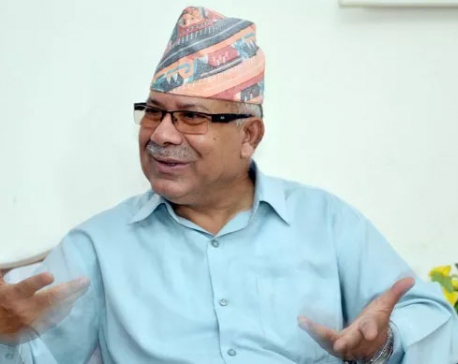
OR
Opinion
Changing Political Landscape of Nepal
Published On: February 18, 2023 09:00 AM NPT By: Dr. Ganesh Mandal

The emergence of new political parties in Nepal has created a platform for a new political discourse. Their significance in today’s politics has become a highly debatable subject. Though this is not the first time in history that new political forces emerged prior to the elections and got a tremendous support from voters, their sustainability has always been doubtful. There is a long history of formation and dissolution of political parties in Nepal.
The Nepal Praja Parishad which was founded in 1936 to lead the revolution against the Rana regime and dissolved in 1941 is considered the first political party in Nepal. Later on, the Nepali Congress and the Communist Party of Nepal were founded in India by Nepali political activists involved in the Indian independence movement with an objective to overthrow the Rana oligarchy and establish democracy in Nepal. Following the success in overthrowing the Rana regime in 1951, a number of other parties emerged to take advantage of the more open political atmosphere. The NC won a two-thirds majority in the first general election held in 1959 and formed Nepal’s first democratic government.
The advent of multiparty democracy in 1990 opened up space once again for political competition and a number of new parties were formed, including the RPP, NSP etc. In the three general elections held in the 1990s, the Nepali Congress and the Communist Party of Nepal (UML) proved to be the main rivals of each other, with one defeating the other in successive elections.
Likewise in the period after 2006, several new parties emerged through appeals to regional and ethnic identity groups. These new forces had been quite influential in shaping the post-2006 political circumstances, introducing alternative discourses for the state restructuring. The Madhesh-based parties were major among them. The Nepal Sadbhavana Party (NSP) was the only party advocating the rights of Madheshis throughout the 1990s and the early 2000s, but since 2006 other Madhesh-based parties came to the front. There were continuous protests; principal among them the Madhesh Movement, in the so-called transition period between 2006 and 2015. This period saw two constituent assembly elections - one in 2008 and the other in 2013, respectively. The Madhesh-based parties fared well in the first CA whereas they performed very badly and won only half as many seats in the second CA.
In the first general election of Nepal held in 2017 according to the new constitution promulgated in 2015, the left parties’ alliance won a majority at the federal level as well as in six out of the seven provinces. The Madhesh-based parties’ alliance formed the provincial government in Madhesh Province (then Province 2), though it had insignificant presence in the rest of the country.
A new wave of young candidates and newly-emerged political parties was seen in the general election of 2022. The results of the elections to the Federal Parliament and the provincial assemblies were marked by an anti-establishment vote along with a new change in the Nepali political society and in the mindset of the citizens. The newly-formed parties made a dramatic entry into the Federal Parliament and provincial assemblies. All of them campaigned with mostly young candidates against institutionalized and organized official corruption, and for better governance. However, the significance of the newly appointed representatives in terms of bringing a new political wave to Nepal is yet to prove.
Election campaigns, agendas and issue ownership are important determinants of election outcomes. Though the policies and ideology of the political parties remain constant over time, the election agenda may vary considerably from one election to the next which defines the frame for the voting decision. Similarly, the party’s leadership should know the significance of issue ownership. They should instinctively understand and prioritize the issues beneficial to them and their party. The essence of election campaigns is to persuade voters towards the candidates and political parties with the ideas and positions on owned issues.
The new political forces emphasized feasible plans and agendas that could make a difference in the people’s lives, rather than big promises. Free health care, free education, effective implementation of constitutional provisions, proper implementation of the fundamental rights enshrined in the constitution, resolving citizenship-related issues and farmers’ problems, corruption-removal, job-creation to prevent youths from going abroad, sustainable economy, were some of their priorities. They emphasized that the people should be able to enjoy the rights guaranteed by the constitution without any hindrance and that the governance structure should be financially sustainable.
However, the traditional political parties neither put emphasis on election campaigns nor agendas. They repeatedly ignored to attach priority to the public concern. The agendas in their election manifestos remain consistent from one election to the other. They always compete with each other in terms of irrational and hypothetical promises rather than feasible ones, and have always failed to implement them. They have been overconfident about the parties’ expanded structure and network up to the community level. These political parties, all the while, have been busy in power games and have been rather unresponsive to the people’s problems.
On the one hand, the major political parties claim to be strictly following the principles of inclusivity and proportional representation enshrined in the Constitution of Nepal 2015, while on the other hand, the essence of the principles are being violated unhesitatingly. Principally, reservations and quotas are clearly meant to lift the marginalized groups, not for the elevation of the already dominant groups. However, on the contrary, there has been the inclusion of privileged candidates from quotas both in the parties’ general conventions and proportional representation candidates list. Similarly, many political couples were brought to the respective central committees and legislature, which was essentially a triumph of nepotism and favoritism over proportional inclusion. Such activities were widely criticized.
Moreover, the voters did not appreciate the idea of forming coalitions prior to the polls. They perceived such coalitions as political syndicates imposed by the major parties to forcefully vote the candidates or political parties regardless of their preferences, violating democratic norms, values and principles. The citizens’ support to the new parties and candidates was at the cost of saving democracy at least.
The Nepali public being extremely frustrated with the previous governments for not getting proper support even during difficult times, showed a huge interest in new political parties and candidates in the elections. With higher hopes and expectations, the Nepali citizens endorsed their agendas and showed wonderful support. But they too have started acting like the traditional parties. Their actions after being elected are in contrast to the commitments they made during the election. In contrast to their slogans against the existing political parties and faces, they showed hastiness in joining hands with them. In a very short period, they are also losing their trust among the Nepali citizens.
There is also an increase in the frequency of protests after the formation of the new government, which indicates the citizens’ increasing dissatisfaction and disappointment with poor governance and the government’s failure to ensure social justice. If not managed appropriately on time, people’s anger and frustrations might take the form of a mass protest and challenge the political system.
You May Like This

Whither the Post-Election Nepali politics?
A well-organized party is essential to orient and manage the cadres. All this requires resources. Why couldn’t old parties/leaders deliver?... Read More...

EC tightens screw on code of conduct breach
KATHMANDU, May 7: With preparations for the May 13 local level election coming to a final phase, the Election Commission... Read More...

Party's name will be Nepal Communist Party after merger: Leader Nepal
KAILALI, Feb 9: CPN-UML leader Madhav Kumar Nepal said that the name of the new party after merger between CPN-UMLand... Read More...










Just In
- NRB introduces cautiously flexible measures to address ongoing slowdown in various economic sectors
- Forced Covid-19 cremations: is it too late for redemption?
- NRB to provide collateral-free loans to foreign employment seekers
- NEB to publish Grade 12 results next week
- Body handover begins; Relatives remain dissatisfied with insurance, compensation amount
- NC defers its plan to join Koshi govt
- NRB to review microfinance loan interest rate
- 134 dead in floods and landslides since onset of monsoon this year









Leave A Comment